Sample size and prediction of weight and yield of individual cuts from Braford steers pistol hindquarters.
Sample size and prediction of weight and yield of individual cuts from Braford steers pistol hindquarters.
Author(s): CARDOSO, L. L.; TAROUCO, J. U.; MACNEIL, M. D.; LOBATO, J. F. P.; DAMBRÓS, M. C.; FREITAS, A. K. de; DEVICENZI, T.; FEIJÓ, F. D.; CARDOSO, F. F.
Summary: ABSTRACT: Two hundred seventeen grass-finished Braford steers were assessed by ultrasonic scanning and subsequently harvested with their pistol hindquarters fabricated into boneless wholesale cuts. The Longissimus thoracis muscle area and subcutaneous fat depths were measured. The objectives of this study were: 1) to develop prediction equations for weights of the pistol hindquarter and high-value commercial cuts, and 2) to estimate sample size needed for experiments comparing pistol hindquarter retail product weight using either physically or ultrasonically measured carcass traits. Carcass measurements explained 44 % to 94 % of the variation in weights of individual cuts, whereas, measurements that were made using ultrasound explained 42 % to 90 % of the variation in the weights. Models used to predict the weight of pistol hindquarter retail product with carcass measures and ultrasound measures showed high coefficient of determination (R2 = 0.92 and 0.97, respectively). Whether based on carcass or ultrasound measures, models used to estimate weight percentage of fat trimmed from the pistol hindquarter had lack of fit. In general, models for individual cuts weights that used traits measured with ultrasound as independent variables approached the accuracy of models using carcass traits. Thus, only slightly greater samples sizes were required to have equivalent power to detect differences in retail product weights using ultrasound measures. For experiments of equivalent power, differences in the number of animals required may be offset by avoiding costs for slaughter and fabrication. Keywords: cattle, carcass, models, ultrasound
Publication year: 2020
Types of publication: Journal article
Observation
Some of Embrapa's publications are published as ePub files. To read them, use or download one of the following free software options to your computer or mobile device. Android: Google Play Books; IOS: iBooks; Windows and Linux: Calibre.
Access other publications
Access the Agricultural Research Database (BDPA) to consult Embrapa's full library collection and records.
Visit Embrapa Bookstore to purchase books and other publications sold by Embrapa.

